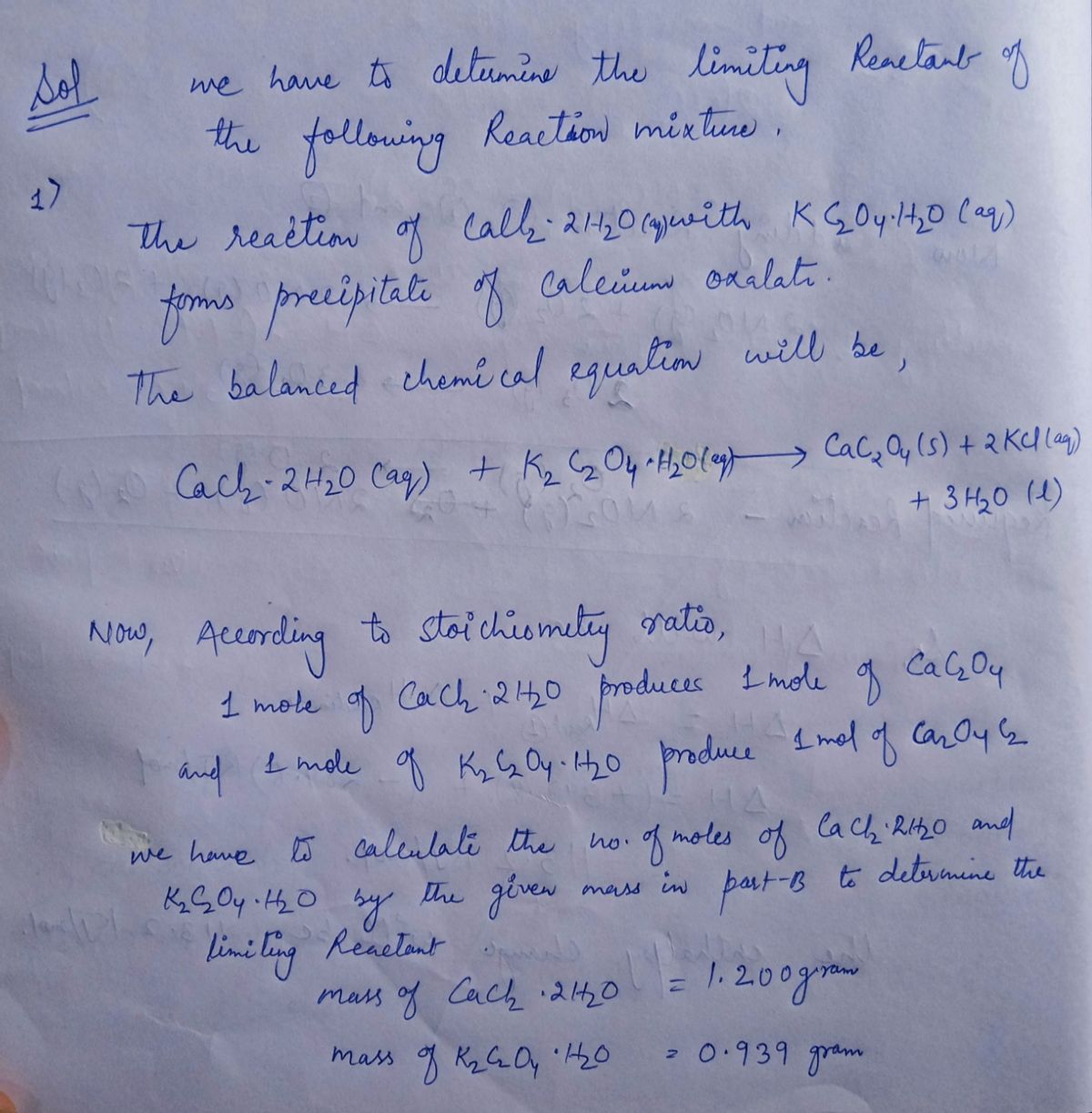ol ini ne baall nael gnblnklo nohanimsis qu odi gairesl moit anodavede uoy bo her shee Data Analysis odmon OBJEC of paper. ТЕСH with, but be sure to show your work. The f CaC,O, H;O. INTR The and as c com 100%. usu. wh gable Th abbe lo al TE al
ol ini ne baall nael gnblnklo nohanimsis qu odi gairesl moit anodavede uoy bo her shee Data Analysis odmon OBJEC of paper. ТЕСH with, but be sure to show your work. The f CaC,O, H;O. INTR The and as c com 100%. usu. wh gable Th abbe lo al TE al
Chemistry
10th Edition
ISBN:9781305957404
Author:Steven S. Zumdahl, Susan A. Zumdahl, Donald J. DeCoste
Publisher:Steven S. Zumdahl, Susan A. Zumdahl, Donald J. DeCoste
Chapter1: Chemical Foundations
Section: Chapter Questions
Problem 1RQ: Define and explain the differences between the following terms. a. law and theory b. theory and...
Related questions
Question
From data analysis number 1

Transcribed Image Text:### Data Analysis
**Instructions:**
Clearly show any necessary calculations and explanations for the following data analysis on another sheet of paper.
1. **Determine the Limiting Reactant:**
- Based on the reactant masses used in your experiment, ascertain the limiting reactant. Compare the result obtained with the result using chemical tests in Part B. Note that there are several methods possible for determining limiting reactants. Use the procedure you are most comfortable with, but ensure to show your work.
2. **Calculate Theoretical Yield:**
- Based on the reactant masses used in your experiment, calculate the theoretical yield (in grams) of CaC₂O₄·H₂O.
3. **Excess Reactant Calculation:**
- Calculate the mass (in grams) of excess reactant that was not consumed in the reaction.
4. **Percent Yield Calculation:**
- a. Calculate the percent yield of CaC₂O₄·H₂O using your actual yield from Part A and the theoretical yield calculated above.
- b. Comment on your percent yield. Include possible explanations for results less than or greater than 100%.
**Note:** Include detailed explanations and show all work for each calculation.
![**A. Precipitation of CaC₂O₄·H₂O**
- Unknown number: [Blank]
**1. Reactant masses (g):**
- CaCl₂·2H₂O: 1.200 g
- K₂C₂O₄·H₂O: 0.939 g
**2. Mass of filter paper (g):** 1.847 g
**3. Mass of filter paper and CaC₂O₄·H₂O (g):** 2.672 g
**4. Mass of CaC₂O₄·H₂O:**
- Calculation: 1.200 g (filter + product) - 1.847 g (filter) = 0.6047 g
---
**B. Determination of Limiting Reactant Based on Chemical Tests**
**Record your observations from testing the supernatant.**
**Results of adding:**
- **CaCl₂·2H₂O:**
- Observation: "Liquid remained slightly cloudy."
- **K₂C₂O₄·H₂O:**
- Observation: "Liquid turned orange, that means some reaction must have occurred."
---
**Limiting reactant (write complete formula):**
- Answer: K₂C₂O₄·H₂O
**Excess reactant (write complete formula):**
- Answer: CaCl₂·2H₂O](/v2/_next/image?url=https%3A%2F%2Fcontent.bartleby.com%2Fqna-images%2Fquestion%2F377a7caf-b074-415b-a7a2-489899521086%2F01062670-2bd2-49c2-ba11-14e62e395321%2F4aur38_processed.jpeg&w=3840&q=75)
Transcribed Image Text:**A. Precipitation of CaC₂O₄·H₂O**
- Unknown number: [Blank]
**1. Reactant masses (g):**
- CaCl₂·2H₂O: 1.200 g
- K₂C₂O₄·H₂O: 0.939 g
**2. Mass of filter paper (g):** 1.847 g
**3. Mass of filter paper and CaC₂O₄·H₂O (g):** 2.672 g
**4. Mass of CaC₂O₄·H₂O:**
- Calculation: 1.200 g (filter + product) - 1.847 g (filter) = 0.6047 g
---
**B. Determination of Limiting Reactant Based on Chemical Tests**
**Record your observations from testing the supernatant.**
**Results of adding:**
- **CaCl₂·2H₂O:**
- Observation: "Liquid remained slightly cloudy."
- **K₂C₂O₄·H₂O:**
- Observation: "Liquid turned orange, that means some reaction must have occurred."
---
**Limiting reactant (write complete formula):**
- Answer: K₂C₂O₄·H₂O
**Excess reactant (write complete formula):**
- Answer: CaCl₂·2H₂O
Expert Solution
Step 1
In the given question we have to determine the limiting reactant of the following Reaction mixture.

Trending now
This is a popular solution!
Step by step
Solved in 2 steps with 3 images

Knowledge Booster
Learn more about
Need a deep-dive on the concept behind this application? Look no further. Learn more about this topic, chemistry and related others by exploring similar questions and additional content below.Recommended textbooks for you

Chemistry
Chemistry
ISBN:
9781305957404
Author:
Steven S. Zumdahl, Susan A. Zumdahl, Donald J. DeCoste
Publisher:
Cengage Learning

Chemistry
Chemistry
ISBN:
9781259911156
Author:
Raymond Chang Dr., Jason Overby Professor
Publisher:
McGraw-Hill Education

Principles of Instrumental Analysis
Chemistry
ISBN:
9781305577213
Author:
Douglas A. Skoog, F. James Holler, Stanley R. Crouch
Publisher:
Cengage Learning

Chemistry
Chemistry
ISBN:
9781305957404
Author:
Steven S. Zumdahl, Susan A. Zumdahl, Donald J. DeCoste
Publisher:
Cengage Learning

Chemistry
Chemistry
ISBN:
9781259911156
Author:
Raymond Chang Dr., Jason Overby Professor
Publisher:
McGraw-Hill Education

Principles of Instrumental Analysis
Chemistry
ISBN:
9781305577213
Author:
Douglas A. Skoog, F. James Holler, Stanley R. Crouch
Publisher:
Cengage Learning

Organic Chemistry
Chemistry
ISBN:
9780078021558
Author:
Janice Gorzynski Smith Dr.
Publisher:
McGraw-Hill Education

Chemistry: Principles and Reactions
Chemistry
ISBN:
9781305079373
Author:
William L. Masterton, Cecile N. Hurley
Publisher:
Cengage Learning

Elementary Principles of Chemical Processes, Bind…
Chemistry
ISBN:
9781118431221
Author:
Richard M. Felder, Ronald W. Rousseau, Lisa G. Bullard
Publisher:
WILEY